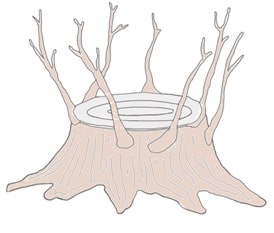Yose-ue (寄せ植え)
Yose Ue style is a small miniature forest model. A group of such trees can be seen in any climatic zone.
Creating this style of bonsai has its advantages. For creating Yose Ue, 2-3-year-old seedlings can be used. Beginners who are eager to see the results of their work can start with this style. Even seedlings that don't have well-developed branches can work for this style, as imperfections can easily be covered by branches of other trees in the group.
It is recommended to select trees of the same species, with small leaves or needles. Of course, a "mixed forest" is possible, but in this case, it’s necessary to select species with similar growth rates and roughly similar-sized leaves. The contrasting difference in leaf sizes due to miniature size makes this style unattractive. A combination of coniferous and deciduous trees is also unsuitable.
Also, the number of seedlings is important. For creating Yose Ue, a specific number of plants is chosen.
This style requires an oval or rectangular, relatively low and long container. The placement of the seedlings in the container is very important: the tallest, thickest seedling should be placed in the front of the container, while the smaller ones should be planted in the back.

First, prepare the required number of seedlings and an appropriate container. When distributing the seedlings in the container, keep in mind that the trunks of all the trees should be clearly visible, do not plant the seedlings in a straight line and avoid any symmetry. In this style, the trees can also be divided into two different groups, with empty space between them. Additionally, the tree group can be arranged on a slightly raised area, a “mound.” If there are two groups, both can be placed on raised spots, with space left at the container's edge level. Alternatively, one group can be placed on a “mound” and the other on the “flat.” Pruning should be used to adjust the height of individual seedlings so that the overall shape of the tree group forms an asymmetrical triangle.

Well-developed plants have roots growing in all directions. Because of this, planting may cause difficulties: the plants in the container are placed very close together, and often the roots will obstruct the seedlings from being positioned in the desired spots. To avoid this, first decide where each seedling should go. Then, on the side where roots are likely to cause an issue, trim as many roots as necessary for the seedling to be placed comfortably. Try not to trim more roots than needed for the plant's healthy development. It’s a good idea to add small holes to the container, in addition to drainage holes. In this style, instead of one tree, multiple should be placed, and extra holes will make it easier to secure seedlings in place with wire.
After a while, the roots of individual seedlings will intertwine. After that, the process of repotting, root pruning, soil replacement, and trimming is done the same as for a regular bonsai.
The Kabudachi (株立)
In order to create this style, the seedling is given free growth until the tree trunk thickens to a certain size. Early in spring, before the buds begin to grow, the tree is pruned completely close to the surface roots, leaving only a small stump on the soil surface. In spring, the dormant buds left on the tree trunk will produce numerous shoots. After growing to a certain size, leave only the shoots necessary for the future bonsai formation. This method for creating the Kabudachi style is only suitable for deciduous trees.


